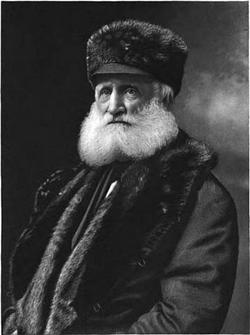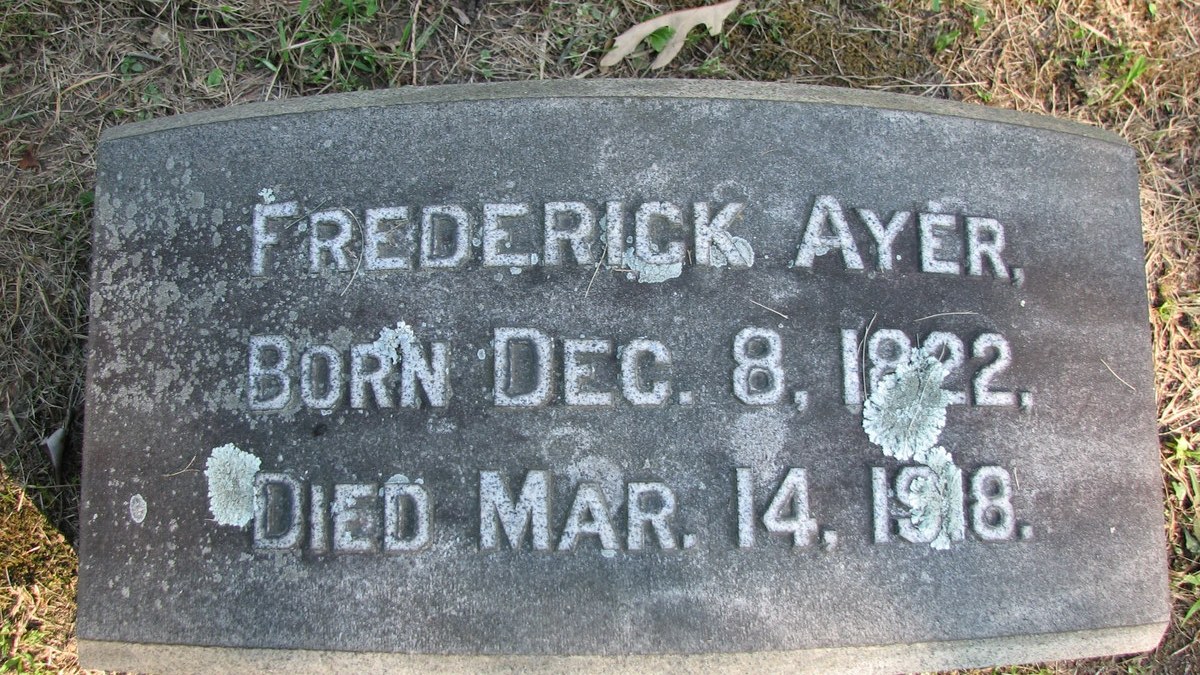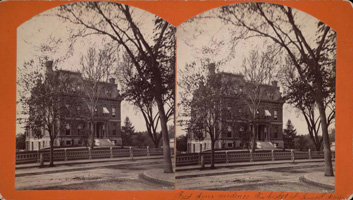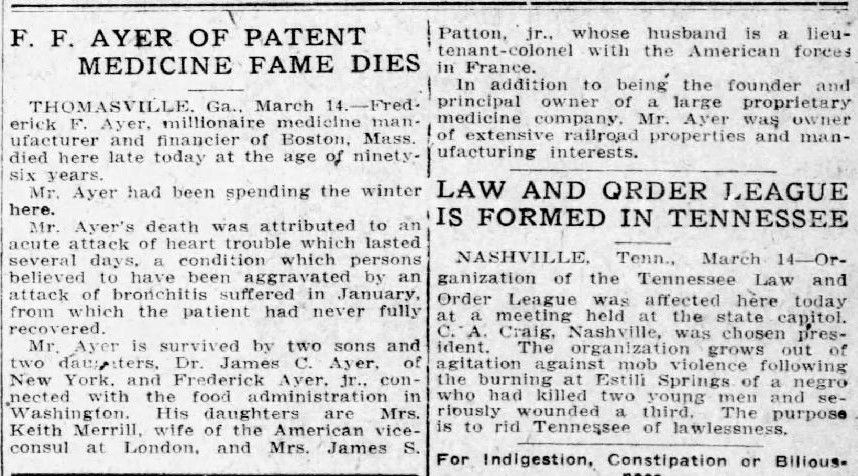FREDERICK AYER was the son of Frederick Ayer, a commissioned officer in the War of 1812, a man highly esteemed by his fellow citizens on account of his fine character and integrity. On his fatheris side he descends from John Ayer, who came from England and settled in Haverhill in 1632, removing to Saybrook early in the eighteenth century. His mother, Persis (Cook) Ayer, was a descendant of the Cook family which came from England and settled at Cambridge, later moving to Preston, Connecticut, where she was born.
Mr. Ayer was born on the eighth day of December, 1822, and at an early age was sent to the public schools in Ledyard, Connecticut, and completed his education at a private academy in Baldwinsville, New York. He then entered the store of John H. Tomlinson & Company, of the latter place, as a clerk. Soon, however, he was sent to Syracuse, New York, as manager of a store belonging to the same firm, which later took him into partnership. Three years later he formed a partnership with Hon. Dennis McCarthy, under the firm name of McCarthy & Ayer, which continued about eleven years, Mr. Ayer withdrawing from this firm in the spring of 1855 for the purpose of joining his brother, Dr. James C. Ayer, in the management of the business of Ayeris Proprietary Medicines, the firm being J. C. Ayer & Company; later, on the death of Dr. Ayer, incorporated as the J. C. Ayer Company. Mr. Frederick Ayer was elected the first treasurer of this corporation, holding this office until 1893, when the pressure of other interests forced him to resign. In 1871 with his brother, James C. Ayer, Frederick Ayer bought a controlling interest in the stock of the Tremont Mills and Suffolk Manufacturing Company of Lowell, consolidating the two companies under the name of the Tremont and Suffolk Mills.
In June, 1885, Mr. Ayer purchased at auction the entire property of the Washington Mills at Lawrence, Massachusetts, and subsequently formed a corporation known as the Washington Mills Company, and became its treasurer.
The American Woolen Company was organized by Mr. Ayer on March 29, 1899, he being the first president of this corporation and continuing in that office until 1905.
Mr. Ayer has had many diversified interests and has assisted largely in the development of new enterprises, for which his advice and cooperation are much valued. He was one of the organizers of the New England Telephone and Telegraph Company, and served as one of its directors until 1896, when he resigned from the board and was succeeded by his son.
Mr. Ayer was one of the organizers and for several years treasurer of the Lake Superior Ship Canal Railway and Iron Company, which owned upwards of four hundred thousand acres of timber and mineral lands in the Upper Peninsula of Michigan, and was one of its directors until its property was taken over by the Keweenaw Association, on whose board of managers he remained for some years when he resigned and was succeeded by his son. He was also one of the builders of the Portage Lake Canal, which runs from Keweenaw Bay across Keweenaw Point, Michigan, connecting Keweenaw Bay with Lake Superior. This canal was afterwards sold to the United States Government.
To-day Mr. Ayer is vice-president and director of the American Woolen Company (New Jersey); president and director American Woolen Company, of New York. Director Boston Elevated Railroad Company; vice-president and trustee Central Savings Bank,of Lowell, Massachusetts; director Columbian National Life Insurance Company; director and vice-president of the International Trust Company; director American Loan and Trust Company; president and director J. C. Ayer Company; president and director Lowell & Ando ver Railroad; director Tremont and Suffolk Mills; director United States Mining Company. He was one of the organizers of the Lowell and Andover Railroad, and has ever since been its president.
He is a member of the Algonquin Club, Beacon Society and Country Clubs of Boston. His favorite exercise is horseback riding.
In 1858 Mr. Ayer was married to Miss Cornelia Wheaton at Syracuse, New York. She died in 1878. There were four children of this marriage, Ellen W., James C., Charles F. and Louise R. Mr. Ayer was married again to Miss Ellen Banning at St. Paul, Minnesota. The children of this marriage are Beatrice В., Katharine and Frederick, Jr.
AYER MANSION: 1876-1908
The former Frederick Ayer Mansion, built in 1876 and perhaps the most ornate building in Lowell, has long been a focal point on Pawtucket Street. This richly decorated Second Empire style residence was designed by Boston architect S.S. Woodcock.
This three-story structure is constructed of brick with sandstone, granite, and wood used throughout the façade as well. Asymmetrical in massing, all of the changes in the planes of the building's rather complicated wall surfaces are echoed in the line of the mansard roof. Windows have rich and varied classical surrounds including segmental, triangular, and flat pediments. Each story is defined by a broad sandstone stringcourse at each floor level and a molded sandstone sill course. The focal point of the façade is an elaborate entry portico with six engaged and four free-standing Corinthian columns, all with highly elaborate carving.
Above, the cornice consists of a broad wooden frieze and moderately projecting eaves supported by carved wooden brackets. Each change in plane of the concave curved and slated mansard roof is defined by wooden rope molding. The six paneled chimneys are inset with sandstone carvings and moldings while decorative iron cresting can be found at the very center of the mansard roof.
The mansion contained 67 rooms with the first floor of the mansion included a drawing room, library, sitting room, dining room, kitchen, music room, smoking room, and other smaller rooms. On the second floor were six bedchambers with accompanying dressing rooms. On the top story there were ten bedrooms. In addition, each floor was connected by a baggage elevator.
Frederick Ayer's mansion reflected his power and wealth as well as the significance of the Ayer family in Lowell. Ayer came to Lowell in 1855 and joined his brother, J.C. Ayer, in his downtown patent medicine firm. Throughout his life, Ayer added to his financial power by making a series of investments. In 1871 he, along with his brother, bought controlling interest in the Tremont in Suffolk Mills. Ayer also had interests in the Washington Mills in Lawrence, the American Woolen Company, the Lake Superior Ship Canal Railway and Iron Company, and the Lowell and Andover Railroad. He was also involved with several Lowell banks and the New England Telephone Company. In 1871, Ayer served on the Board of Aldermen and later as the Chairman of the Board of Health.
FREDERICK AYER was the son of Frederick Ayer, a commissioned officer in the War of 1812, a man highly esteemed by his fellow citizens on account of his fine character and integrity. On his fatheris side he descends from John Ayer, who came from England and settled in Haverhill in 1632, removing to Saybrook early in the eighteenth century. His mother, Persis (Cook) Ayer, was a descendant of the Cook family which came from England and settled at Cambridge, later moving to Preston, Connecticut, where she was born.
Mr. Ayer was born on the eighth day of December, 1822, and at an early age was sent to the public schools in Ledyard, Connecticut, and completed his education at a private academy in Baldwinsville, New York. He then entered the store of John H. Tomlinson & Company, of the latter place, as a clerk. Soon, however, he was sent to Syracuse, New York, as manager of a store belonging to the same firm, which later took him into partnership. Three years later he formed a partnership with Hon. Dennis McCarthy, under the firm name of McCarthy & Ayer, which continued about eleven years, Mr. Ayer withdrawing from this firm in the spring of 1855 for the purpose of joining his brother, Dr. James C. Ayer, in the management of the business of Ayeris Proprietary Medicines, the firm being J. C. Ayer & Company; later, on the death of Dr. Ayer, incorporated as the J. C. Ayer Company. Mr. Frederick Ayer was elected the first treasurer of this corporation, holding this office until 1893, when the pressure of other interests forced him to resign. In 1871 with his brother, James C. Ayer, Frederick Ayer bought a controlling interest in the stock of the Tremont Mills and Suffolk Manufacturing Company of Lowell, consolidating the two companies under the name of the Tremont and Suffolk Mills.
In June, 1885, Mr. Ayer purchased at auction the entire property of the Washington Mills at Lawrence, Massachusetts, and subsequently formed a corporation known as the Washington Mills Company, and became its treasurer.
The American Woolen Company was organized by Mr. Ayer on March 29, 1899, he being the first president of this corporation and continuing in that office until 1905.
Mr. Ayer has had many diversified interests and has assisted largely in the development of new enterprises, for which his advice and cooperation are much valued. He was one of the organizers of the New England Telephone and Telegraph Company, and served as one of its directors until 1896, when he resigned from the board and was succeeded by his son.
Mr. Ayer was one of the organizers and for several years treasurer of the Lake Superior Ship Canal Railway and Iron Company, which owned upwards of four hundred thousand acres of timber and mineral lands in the Upper Peninsula of Michigan, and was one of its directors until its property was taken over by the Keweenaw Association, on whose board of managers he remained for some years when he resigned and was succeeded by his son. He was also one of the builders of the Portage Lake Canal, which runs from Keweenaw Bay across Keweenaw Point, Michigan, connecting Keweenaw Bay with Lake Superior. This canal was afterwards sold to the United States Government.
To-day Mr. Ayer is vice-president and director of the American Woolen Company (New Jersey); president and director American Woolen Company, of New York. Director Boston Elevated Railroad Company; vice-president and trustee Central Savings Bank,of Lowell, Massachusetts; director Columbian National Life Insurance Company; director and vice-president of the International Trust Company; director American Loan and Trust Company; president and director J. C. Ayer Company; president and director Lowell & Ando ver Railroad; director Tremont and Suffolk Mills; director United States Mining Company. He was one of the organizers of the Lowell and Andover Railroad, and has ever since been its president.
He is a member of the Algonquin Club, Beacon Society and Country Clubs of Boston. His favorite exercise is horseback riding.
In 1858 Mr. Ayer was married to Miss Cornelia Wheaton at Syracuse, New York. She died in 1878. There were four children of this marriage, Ellen W., James C., Charles F. and Louise R. Mr. Ayer was married again to Miss Ellen Banning at St. Paul, Minnesota. The children of this marriage are Beatrice В., Katharine and Frederick, Jr.
AYER MANSION: 1876-1908
The former Frederick Ayer Mansion, built in 1876 and perhaps the most ornate building in Lowell, has long been a focal point on Pawtucket Street. This richly decorated Second Empire style residence was designed by Boston architect S.S. Woodcock.
This three-story structure is constructed of brick with sandstone, granite, and wood used throughout the façade as well. Asymmetrical in massing, all of the changes in the planes of the building's rather complicated wall surfaces are echoed in the line of the mansard roof. Windows have rich and varied classical surrounds including segmental, triangular, and flat pediments. Each story is defined by a broad sandstone stringcourse at each floor level and a molded sandstone sill course. The focal point of the façade is an elaborate entry portico with six engaged and four free-standing Corinthian columns, all with highly elaborate carving.
Above, the cornice consists of a broad wooden frieze and moderately projecting eaves supported by carved wooden brackets. Each change in plane of the concave curved and slated mansard roof is defined by wooden rope molding. The six paneled chimneys are inset with sandstone carvings and moldings while decorative iron cresting can be found at the very center of the mansard roof.
The mansion contained 67 rooms with the first floor of the mansion included a drawing room, library, sitting room, dining room, kitchen, music room, smoking room, and other smaller rooms. On the second floor were six bedchambers with accompanying dressing rooms. On the top story there were ten bedrooms. In addition, each floor was connected by a baggage elevator.
Frederick Ayer's mansion reflected his power and wealth as well as the significance of the Ayer family in Lowell. Ayer came to Lowell in 1855 and joined his brother, J.C. Ayer, in his downtown patent medicine firm. Throughout his life, Ayer added to his financial power by making a series of investments. In 1871 he, along with his brother, bought controlling interest in the Tremont in Suffolk Mills. Ayer also had interests in the Washington Mills in Lawrence, the American Woolen Company, the Lake Superior Ship Canal Railway and Iron Company, and the Lowell and Andover Railroad. He was also involved with several Lowell banks and the New England Telephone Company. In 1871, Ayer served on the Board of Aldermen and later as the Chairman of the Board of Health.
Family Members
Sponsored by Ancestry
Advertisement
Records on Ancestry
Advertisement
























